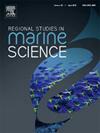基于MaxEnt物种分布模型的南海北部黄鳝生境适宜性研究
IF 2.1
4区 环境科学与生态学
Q3 ECOLOGY
引用次数: 0
摘要
金枪鱼(Thunnus spp.)是南海北部的顶级捕食者和重要的渔业资源。利用MaxEnt模型分析了2016 - 2020年南海北部金枪鱼(Thunnus spp.)的季节变化和主要环境驱动因素,对其生境适宜性进行了评估。利用广东省渔业资源数据收集系统的金枪鱼发生数据,以及环境变量(叶绿素-a、海面盐度、海面高度和温度)。使用AUC验证模型性能,并使用每单位工作量捕获(CPUE)数据验证模型性能。模型的AUC TRAIN值在0.805 ~ 0.864之间,AUC TEST值在0.795 ~ 0.839之间,具有较好的预测效果。Chl-a是春季的主要驱动因素,而SSS对秋季的影响更大,最佳海温在24 ~ 27℃范围内。适宜生境(HSI >;0.8)的空间覆盖率在4月(7525 km²)和9月(9656 km²)达到最高,这与CPUE值在这两个时期的增加相一致。该模型有效地捕捉到了物种空间分布的季节变化;使用额外的预测器进一步细化可能会导致更准确的预测。这些发现为适应性渔业管理提供了重要见解,支持对气候驱动的变化做出明智的反应,并促进区域金枪鱼种群的未来可持续性。本文章由计算机程序翻译,如有差异,请以英文原文为准。
Habitat suitability of Thunnus spp. in the Northern South China Sea based on the MaxEnt species distribution model
Tuna (Thunnus spp.) are apex predators and vital fishery resources in the Northern South China Sea. This study assesses the habitat suitability of tuna (Thunnus spp.) in the northern South China Sea using the MaxEnt model to analyze seasonal shifts and key environmental drivers from 2016 to 2020. Tuna occurrence data from the Guangdong Fishery Resources Data Collection System, along with environmental variables (Chlorophyll-a, sea surface salinity, sea surface height, and temperature), were utilized. Model performance was validated using the AUC and verified with catch per unit effort (CPUE) data. The model demonstrated a satisfactory predictive performance, with AUC TRAIN values ranging from 0.805 to 0.864, AUC TEST values from 0.795 to 0.839. Chl-a was the primary driver in spring, whereas SSS had a greater influence in autumn, with optimal SST ranging from 24 °C to 27°C. Suitable habitat (HSI > 0.8) reached its highest spatial coverage in April (7525 km²) and September (9656 km²), aligning with increased CPUE values during those periods. The model effectively captured seasonal variations in the species' spatial distribution; further refinement using additional predictors may lead to more accurate predictions. These findings provide important insights for adaptive fisheries management, supporting informed responses to climate-driven changes and promoting the future sustainability of regional tuna populations.
求助全文
通过发布文献求助,成功后即可免费获取论文全文。
去求助
来源期刊

Regional Studies in Marine Science
Agricultural and Biological Sciences-Ecology, Evolution, Behavior and Systematics
CiteScore
3.90
自引率
4.80%
发文量
336
审稿时长
69 days
期刊介绍:
REGIONAL STUDIES IN MARINE SCIENCE will publish scientifically sound papers on regional aspects of maritime and marine resources in estuaries, coastal zones, continental shelf, the seas and oceans.
 求助内容:
求助内容: 应助结果提醒方式:
应助结果提醒方式:


